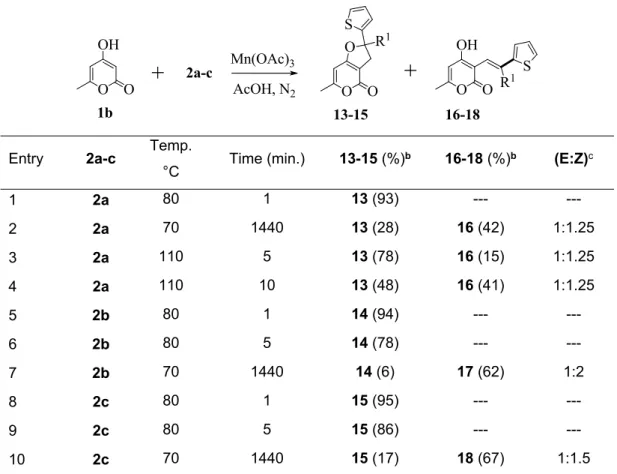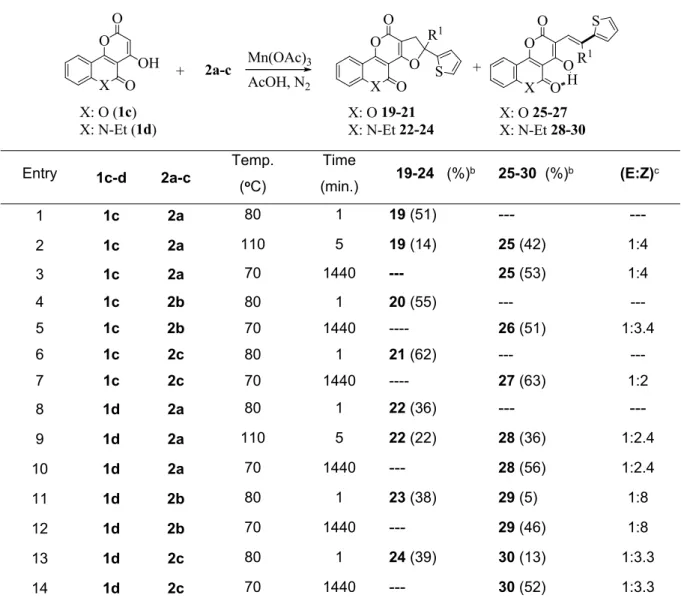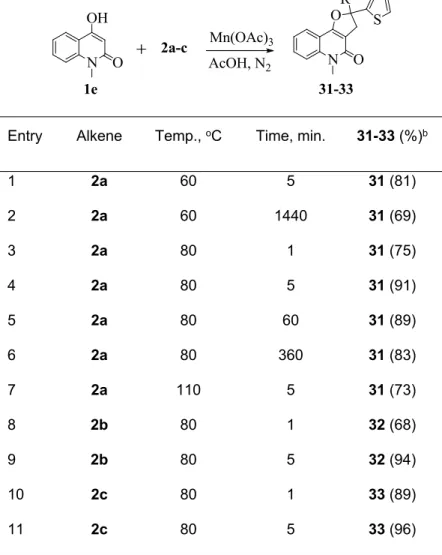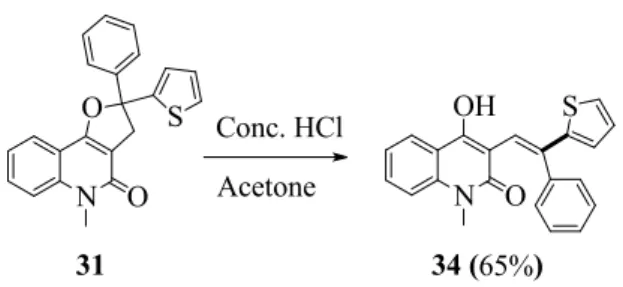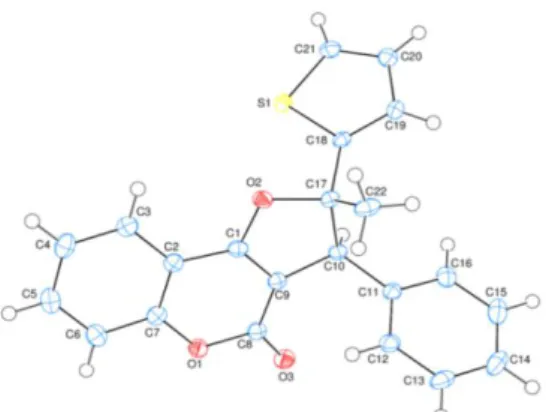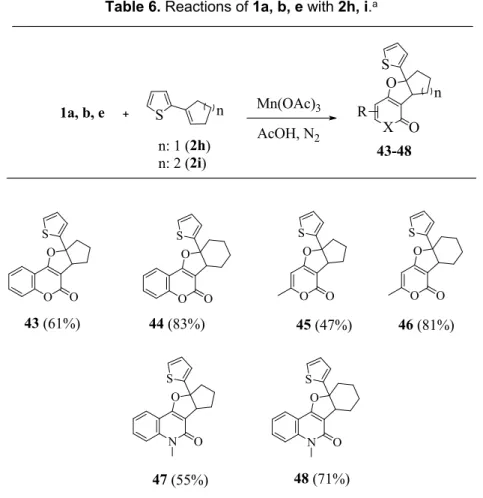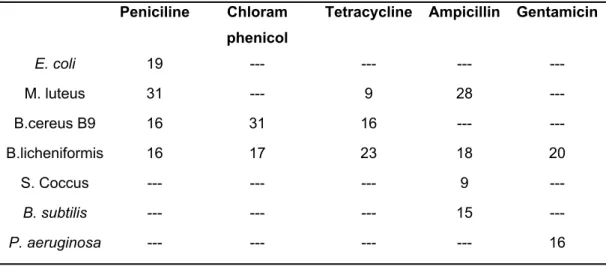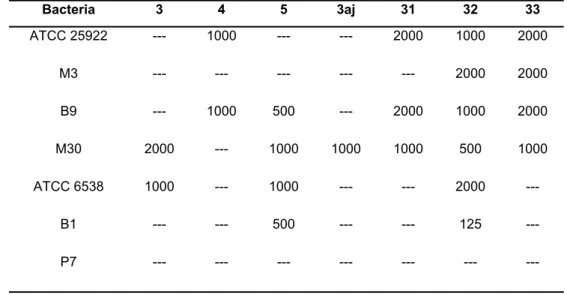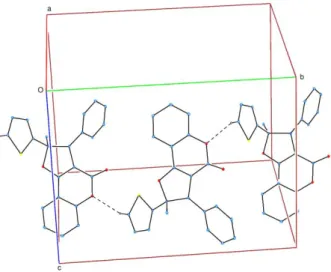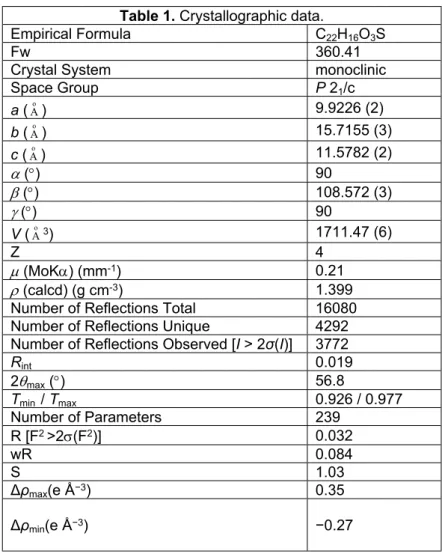Efficient Syntheses and Antimicrobial Activities of New Thiophene Containing Pyranone and Quinolinone Derivatives by Manganese(III) Acetate. The effect of
Thiophene on Ring Closure‑ Opening Reactions
journal or
publication title
New Journal of Chemistry
volume 43
page range 5737‑5751
year 2019‑05‑20
URL http://hdl.handle.net/2298/00031532
doi: 10.1039/C9NJ00054B
2
Efficient Syntheses and Antimicrobial Activities of New Thiophene Containing Pyranone and Quinolinone Derivatives by Manganese(III) Acetate. The effect of Thiophene on Ring Closure-
Opening Reactions
Mehtap Özgüra*, Mehmet Yılmazb, Hiroshi Nishinoc, Eda Çinar Avard, Hakan Dale, A.Tarık Pekela and Tuncer Hökelekf
aDepartment of Chemistry, Ankara University, 06100 Ankara, TURKEY
bDepartment of Chemistry, Kocaeli University, 41380 Kocaeli, TURKEY
cDepartment of Chemistry, Kumamoto University, Kurokami, Kumamoto 860-8555, JAPAN
dDepartment of Chemistry, Gazi University, 06500 Ankara, TURKEY
eDepartment of Chemistry, Anadolu University, 26470 Yenibağlar, Eskişehir, TURKEY
fDepartment of Physics, Hacettepe University, 06800 Beytepe, Ankara, TURKEY
ABSTRACT
The syntheses of new series of pyranones, namely fused pyranones and quinoline-based dihydrofurans accompanied by 3-alkenyl-substituted structures were described. The products were regioselectively formed Mn(III)-mediated oxidation at elevated temperature in order to obtain excellent yields. The effects on product distributions of the thiophene group together with the temperatures and reactions time were investigated. The structures of the syntheses compounds were determined on the basis of spectroscopic (IR, 1H NMR, 13C NMR, COSY, HSQC, HMBC and elemental analysis) and X-ray crystallographic data.
In addition, the in vitro antimicrobial activities of the some syntheses dihydrofurans were tested against G (+) and G (-) bacteria using disc diffusion method. The results indicated that the compounds containing thiophene group showed a better antimicrobial effect than some commonly used antibiotics.
antimicrobial activity
*Corresponding authors. Tel: +90 3122126720 Fax: +90 3122232395 E-mail address: myakut@ankara.edu.tr [M. Özgür]
Keywords: manganese(III) acetate, dihydrofuran, 3-alkenyl–substituted coumarin, thiophene, 4
5 6 7 8 9 10 11 12 13 14 15 16 17 18 19 20 21 22 23 24 25 26 27 28 29 30 31 32 33 34 35 36 37 38 39 40 41 42 43 44 45 46 47 48 49 50 51 52 53 54 55 56 57 58 59 60
1. Introduction
Pyranones are amongst the most abundant molecules of naturally occurring compounds and commonly used as versatile intermediates in natural product synthesis.1 Among pyranone derivatives, coumarins and pyranocoumarines are an important class of organic compounds, and used as the building blocks of many biologically active molecules2 exhibiting significant pharmacological activities such as anticoagulant,3a antitumor,3b anti-imflammatory,3c antibacterial3d and cytotoxic activities.3e Morover, 4- hydroxy-3-substituted pyranones have been used as fluorescent chemosensors,4a molecular switches,4b luminescence dyes4c and optical sensors4d owing to their conjugated features and biological activities.5 Quinolinone and its derivatives are in another important class of heterocycles that are widely distributed in nature.6 Dihydrofuroquinolinones and pyranoquinolinones, in particular, have found a great deal of interest since they have many applications in medicine and their biological activities were also demonstrated in literature.7 Thiophenes, another important group of heterocyclic molecules, possess versatile applications in various fields of drug development.8
In this respect, here we aimed at incorporating pyranone, coumarin and quinolinone as scaffold of the target molecules in the presence of thiophene moiety. Since Mn(III)-based oxidative radical cyclization using 1,3-dicarbonyl compounds has become the most preferred way of preparing a variety of heterocycles,9, 10 we utilized the reaction11 in order to obtain heteroaromatic compounds containing dihydrofurans, and we found to synthesize highly functionalized dihydrofuran-fused pyranone, coumarin and quinolinone derivatives. We herein report a novel and efficient one-step synthetic protocol of biological active pyranones, dihydrofuran-fused and 3-alkenyl-substituted quinoline derivatives (Scheme 1).
OH OR1 S
OH S Mn(OAc)
O S
R1 O
S R1
2f, g 2a-e
4 5 6 7 8 9 10 11 12 13 14 15 16 17 18 19 20 21 22 23 24 25 26 27 28 29 30 31 32 33 34 35 36 37 38 39 40 41 42 43 44 45 46 47
4 2. Results and discussion
2.1. Synthesis
2.1.1 Reactions of 1,1-disubstituted alkenes with 1a-e.
We firstly examined the reaction of 4-hydroxycoumarin (1a) with thienyl substituted alkenes 2a-e under different reaction conditions (Table 1). During the reaction at 110 °C for 5 minutes, two products were obtained. One was dihydrofuro derivatives 3-7, and the other was 3-alkenyl-substituted compounds 8- 12 (Table 1).
The IR spectra of compounds 3-7 showed a characteristic strong carbonyl absorption at 1720 cm-1. The chemical shifts of the carbonyl groups were found at 160-161 ppm assigned to lactone carbonyl, which demonstrated that isolated compounds were angular. In addition, H-9 proton of the angular dihydrofurocoumarin in the 1H NMR spectrum resonated at 7.7 ppm (dd), while in the linear 2,3-dihydro- 4H-furo[2,3-b]chromen-4-one, it is H-5 proton appeared at 8.25 ppm (dd or d) .12a Besides, it was determined that H-9 and H-3 protons correlated with C9a carbon, and H-3 protons weakly interacted with C4 ester carbonyl in the HMBC experiment.
In the reactions, 4-hydroxy-3-alkenylcoumarins 8-12 were unexpectedly obtained in the form of E/Z isomer mixture (Table 1). The existence of hydroxyl and alkenic protons in the 1H NMR spectrum, supported the structure. Besides, in the 1H NMR spectra of compounds 3-7, H-3 methylene protons showed a diastereotopic feature (2J = 15.2-15.6 Hz as a d). These protons were not observed in the spectra of compounds 8-12. In the reaction performed using manganese(III) acetate, it was found that more alkenyl-substituted compounds such as 8-12 were produced by increasing the temperature and prolonging the duration of the reaction. Regarding the reactions performed in acetic acid for 24 h, dihydrofurocoumarins 3-7 were formed in lower yields (Entries 7, 14) or not isolated (Entries 11, 19) and alkene derivatives 8-12 were preferentially produced.
4 5 6 7 8 9 10 11 12 13 14 15 16 17 18 19 20 21 22 23 24 25 26 27 28 29 30 31 32 33 34 35 36 37 38 39 40 41 42 43 44 45 46 47 48 49 50 51 52 53 54 55 56 57 58 59 60
Table 1. Reaction of 4-hydroxycoumarin (1a) with 1,1-disubstituted alkenes 2a-e.
O OH
O
S R1
Mn(OAc)3
AcOH, N2 O O
O R1
O OH
1a 2a-e 3-7 8-12
R1: Ph (2a), 4-Me-C6H4(2b), 4-F-C6H4(2c), Me (2d), 2-Thienyl (2e)
9 3
S
O R1 S
Entry Alkene Temp.
(°C) Time
(min.) 3-7 (%)b 8-12 (%)b (E/Z)c
1 2a 80 1 3 (93) ---- ----
2 2a 80 5 3 (89) ---- ----
3 2a 80 10 3 (76) 8 (8) 1:1.70
4 2a 80 60 3 (62) 8 (23) 1:1.70
5 2a 70 5 3 (86) ---- ----
6 2a 70 60 3 (63) 8 (15) 1:1.70
7 2a 70 1440 3 (3) 8 (67) 1:1.70
8 2a 110 5 3 (63) 8 (27) 1:1.70
9 2b 80 1 4 (94) --- ----
10 2b 80 5 4 (77) 9 (16) 1:4.25
11 2b 70 1440 --- 9 (68) 1:4.25
12 2c 80 1 5 (97) ---- ----
13 2c 60-70 30 5 (68) 10 (16) 1:1.5
14 2c 70 1440 5 (9) 10 (71) 1:1.5
15 2d 80 1 6 (87) ---- ----
16 2d 110 5 6 (85) 11 (10) ----
17 2d 70 1440 6 (32) 11 (14) ----
18 2e 80 1 7 (57) 12 (28) ----
19 2e 70 1440 ---- 12 (79) ----
a All the reactions were carried out in a 1 : 2 : 3 molar ratio of alkene 2, 4-hydroxycoumarin (1a) and Mn(OAc)3 in AcOH.
b Isolated yield based on the alkene 2.
c E:Z ratio determined by 1H NMR spectrum.
This situation shows that alkenyl-substitue coumarin 8 should be formed by the ring-opening reaction of dihydrofurocoumarin 3 under acidic condition (vi and v ways). The proposed reaction mechanism for the formation of alkenyl substituted compounds E and E’ is shown in Scheme 2. As it can be seen at the 4
5 6 7 8 9 10 11 12 13 14 15 16 17 18 19 20 21 22 23 24 25 26 27 28 29 30 31 32 33 34 35 36 37 38 39 40 41 42 43 44 45 46 47
6
Scheme 2. The proposed mechanism for the formation of alkenyl-substituted compounds.
In literature, alkenyl-substituted products were not obtained in the reactions of 4-hydroxycoumarin (1a) with non-heteroaromatic alkenes.11j-k At the reactions that we practiced, it is thought that thiophene group would be effective in the formation of alkenyl-substituted products. With the intention of comparison, the reaction was practiced using 1,1-diphenylethene (2j) even in the high temperature, only dihydrofurocoumarin (3aj) was produced11k and alkenyl-substituted coumarin 4aj was not obtained in the reaction. It was synthesized only when the obtained 3aj was treated with the concentrated HCl (Scheme 3).
O O O
O OH
O 3aj
(89%) 4aj
(79%) conc.HCl
O OH
O
1a 2j
Mn(OAc)3
AcOH, N2
Scheme 3. Reaction of 4-hydroxycoumarin (1a) with 2j.
With addition of thiophene ring to the structure, the products 8, 11 and 12 were produced in acetic acid and effective in the yields of alkenyl-substituted compounds. This situation has the following effects; 1.
Opening of the ring could occur by the electron pair over the sulfur atom at the thiophene ring and the electron pair over the oxygen at the furan ring pushing each other; 2. The enol hydrogens 8-12 and the sulfur atom at the thiophene ring could interact and constitute a more stable structure; 3. While a stronger acid was needed for the formation of 4aj, the products 8-12, they should be formed under the acetic 4
5 6 7 8 9 10 11 12 13 14 15 16 17 18 19 20 21 22 23 24 25 26 27 28 29 30 31 32 33 34 35 36 37 38 39 40 41 42 43 44 45 46 47 48 49 50 51 52 53 54 55 56 57 58 59 60
acid conditions. This might result from the redundant density of electron over the oxygen at the furan ring of 3-7.
The reaction of 4-hydroxy-6-methyl-2H-pyran-2-one (1b) with 2a-c gave dihydrofuropyrans 13-15 and alkenyl substituted pyrans 16-18 (Table 2). The ester carbonyl groups were observed at 1730 cm-1 in the IR spectra, and they were resonated at 160-165 ppm in 13C NMR spectra, so it was determined that the dihydrofuropyrans 13-15 were the angular products. The alkenyl substituted pyrans 16-18 were obtained as an E/Z isomeric mixture. Existence of hydroxyl and alkene protons in compounds 16-18 was found by the help of 1H NMR, COSY, HSQC and HMBC spectra. It was determined that C-4 to which oxygen atom was bounded resonates at 166 ppm, C-2 at 163 ppm and C-6 resonates at 161 ppm in the analysis of 13C NMR spectra.
Table 2. Reaction of 4-hydroxy-6-methyl-2H-pyran-2-one (1b) with 2a-c.a
O O O R1 S
O O OH
O OH
O R1 S 1b
2a-c
13-15 16-18
Mn(OAc)3 AcOH, N2
Entry 2a-c Temp.
°C Time (min.) 13-15 (%)b 16-18 (%)b (E:Z)c
1 2a 80 1 13 (93) --- ---
2 2a 70 1440 13 (28) 16 (42) 1:1.25
3 2a 110 5 13 (78) 16 (15) 1:1.25
4 2a 110 10 13 (48) 16 (41) 1:1.25
5 2b 80 1 14 (94) --- ---
6 2b 80 5 14 (78) --- ---
7 2b 70 1440 14 (6) 17 (62) 1:2
8 2c 80 1 15 (95) --- ---
9 2c 80 5 15 (86) --- ---
10 2c 70 1440 15 (17) 18 (67) 1:1.5
4 5 6 7 8 9 10 11 12 13 14 15 16 17 18 19 20 21 22 23 24 25 26 27 28 29 30 31 32 33 34 35 36 37 38 39 40 41 42 43 44 45 46 47
8
The cyclization reactions of 4-hydroxy-2H,5H-pyrano[3,2-c]chromen-2,5-dione (1c) and 6-ethyl-4- hydroxy-2H-pyrano[3,2-c]quinoline-2,5-dione (1d) with 2a-c resulted in the synthesis of both dihydrofurans 19-24 and alkenes 25-30 (Table 3). The reactions were monitored by TLC and it was determined that the alkenes 25-30 started to form after 2 minutes. Besides, in the reactions carried out at 110 oC (Entry 2 and 9), the alkenes 25 and 28 were obtained with a higher yield than the dihydrofurans 19 and 22. The alkenyl-substituted pyranocoumarins 25-27 and pyranoquinolinones 28-30 were also isolated in E/Z isomeric mixtures.
Table 3. Reaction of 1c, d with 2a-c.
X O O
O OH
X O O
O O
R1 S
O O
O S
X O 2a-c Mn(OAc)3
AcOH, N2
X: O (1c)
X: N-Et (1d) X: O19-21
X: N-Et22-24 X: O25-27 X: N-Et28-30
H R1
+ +
Entry 1c-d 2a-c Temp.
(oC)
Time
(min.) 19-24 (%)b 25-30 (%)b (E:Z)c
1 1c 2a 80 1 19 (51) --- ---
2 1c 2a 110 5 19 (14) 25 (42) 1:4
3 1c 2a 70 1440 --- 25 (53) 1:4
4 1c 2b 80 1 20 (55) --- ---
5 1c 2b 70 1440 ---- 26 (51) 1:3.4
6 1c 2c 80 1 21 (62) --- ---
7 1c 2c 70 1440 ---- 27 (63) 1:2
8 1d 2a 80 1 22 (36) --- ---
9 1d 2a 110 5 22 (22) 28 (36) 1:2.4
10 1d 2a 70 1440 --- 28 (56) 1:2.4
11 1d 2b 80 1 23 (38) 29 (5) 1:8
12 1d 2b 70 1440 --- 29 (46) 1:8
13 1d 2c 80 1 24 (39) 30 (13) 1:3.3
14 1d 2c 70 1440 --- 30 (52) 1:3.3
aAll the reactions were carried out in a 1 : 2 : 3 molar ratio of alkenes 2, pyranocoumarin 1c or pyranoquinolinone 1d and Mn(OAc)3 in AcOH.
bIsolated yield based on the alkenes 2.
c E/Z ratio determined by 1H NMR spectrum.
4 5 6 7 8 9 10 11 12 13 14 15 16 17 18 19 20 21 22 23 24 25 26 27 28 29 30 31 32 33 34 35 36 37 38 39 40 41 42 43 44 45 46 47 48 49 50 51 52 53 54 55 56 57 58 59 60
The last cyclization was examined using 1,1-disubstituted alkenes 2a-c and 4-hydroxy-1-methyl- quinoline-2-one (1e). As a result, only angular dihydrofuroquinolinones 31-33 were produced (Table 4).
Table 4. Reaction of 1e with 2a-c.a
Mn(OAc)3 AcOH, N2 1e
N OH
O 2a-c
N O OR1
31-33 S
Entry Alkene Temp., oC Time, min. 31-33 (%)b
1 2a 60 5 31 (81)
2 2a 60 1440 31 (69)
3 2a 80 1 31 (75)
4 2a 80 5 31 (91)
5 2a 80 60 31 (89)
6 2a 80 360 31 (83)
7 2a 110 5 31 (73)
8 2b 80 1 32 (68)
9 2b 80 5 32 (94)
10 2c 80 1 33 (89)
11 2c 80 5 33 (96)
aAll the reactions were carried out in a 1 : 2 : 3 molar ratio of alkenes 2, quinolinone 1e and Mn(OAc)3 in AcOH.
bIsolated yield based on the alkenes 2.
Both angular and linear dihydrofuroquinolinones were synthesized from the reactions with non- 4
5 6 7 8 9 10 11 12 13 14 15 16 17 18 19 20 21 22 23 24 25 26 27 28 29 30 31 32 33 34 35 36 37 38 39 40 41 42 43 44 45 46 47
10 N O
O
N OH
O S
34 (65%) Conc. HCl
Acetone 31
S
Scheme 4. Ring-opening reaction of dihydrofuroquinolinone 31.
2.1.2 Reactions of 1,2-disubstituted 2f and 1,1,2-trisubstituted alkenes 2g with 1a-c and formation of dihydrofuran as a cis-trans isomer.
When the reactions of 1,2-disubstituted 2f and 1,1,2-trisubstituted alkenes 2g with 4-hydroxycoumarin (1a) was carried out in the presence of manganese(III) acetate, two different dihydrofurocoumarins were isolated (Table 5). In order to characterize the structures, the IR, 1H-NMR and 13C-NMR spectra, HSQC and HMBC spectra were taken and it was deduced that the compounds 35 and 36 were cis and trans isomer. In the 1H- NMR spectrum, the coupling constants of H-2 and H-3 protons were 3JH-H = 6.0 Hz in 35 and 3JH-H= 9.2 Hz in 36. By comparing with the data in the literature,12b,c it was determined that 35 and 36 should be “trans” and
“cis” isomers, respectively (Table 5).
Table 5. Reactions of 1a-c with 2f, g.a
O OH
O
R1 S +
Mn(OAc)3 AcOH, N2 R1: H (2f)
R1: Me (2g)
R
O O O
S R1
O O O
S R1 R + R
1a-c
O O O
O O O
S
O O O
S
O O O
S
O O O
O
O S
O O O
O
O S O O
O S
O O O
S
35(31%) 36(8%) 37(61%) 38(12%)
39(49%) 40(27%) 41(22%) 42(9%)
S
a All the reactions were carried out in a 1 : 2 : 3 molar ratio of alkene 2, 1a-c and Mn(OAc)3
in AcOH at 80 oC, 5 minutes.
b Isolated yield based on the alkene 2.
4 5 6 7 8 9 10 11 12 13 14 15 16 17 18 19 20 21 22 23 24 25 26 27 28 29 30 31 32 33 34 35 36 37 38 39 40 41 42 43 44 45 46 47 48 49 50 51 52 53 54 55 56 57 58 59 60
When HMBC experiments of the dihydrofurocoumarins 35 and 36 were performed, it was found out that C-2 carbon interacted with thienyl H-3 proton and C-3 carbon interacted with ortho protons over phenyl ring. Regarding this, it was found out that in both compounds, thienyl group should be bound to C-2 carbon and phenyl group should be bound to C-3 carbon.
From the reaction of 2g with 1a-c, two different dihydrofurans cis and trans isomer 37-42 were also produced (Table 5). The structure of 37 was confirmed by X-ray crystallography(Fig. 1). 13 According to this analysis, it was determined that phenyl and thienyl groups were in trans position as regards to each other.
Fig. 1. The molecular entities of compound 37, showing the atom-numbering scheme. Displacement ellipsoids are drawn at the 50% probability level.
2.1.3 Reactions of cyclic alkenes 2h, i with 1a, b and 1e
Finally, only dihydrofurans 43-48 were obtained from the reactions of 1a, b and 1e with cyclic alkenes 2h, i. With the purpose of monitoring the formation of alkenyl substituted compounds, various experiments were carried out at high temperatures and in long durations (Table 6).
Unlike the reactions that were practiced with alkenes 2a-c, alkenyl substituted compounds did not produce. However, the products 43 and 44 could be converted into 49 and 50 by treatment of concentrated HCl in 65% and 66% yields, respectively, as a single isomer (Scheme 5).
S S
4 5 6 7 8 9 10 11 12 13 14 15 16 17 18 19 20 21 22 23 24 25 26 27 28 29 30 31 32 33 34 35 36 37 38 39 40 41 42 43 44 45 46 47
12
Table 6. Reactions of 1a, b, e with 2h, i.
O O O S
43(61%)
O O O S
44(83%)
O O O S
O O O S
N O O S
N O O S
45(47%) 46(81%)
47(55%) 48(71%)
S n Mn(OAc)3
AcOH, N2 1a, b, e
n: 1 (2h)
n: 2 (2i) 43-48
X O
O n
S R
a All the reactions were carried out in a 1 : 2 : 3 molar ratio of alkenes 2h, i, pyranones 1a, b, e and Mn(OAc)3 in AcOH at 80 oC, 5 minutes.
b Isolated yield based on the alkene 2.
2.2 Antimicrobial activity study
When the literature studies were examined, it could be clearly seen that quinolone and coumarin derivatives had antimicrobial activities. Moreover, quinolones are among the largest antimicrobial classes.14 Quinolones are synthetic substances obtained by chemical routes different from many antibiotics obtained from living microorganisms. In this study, antimicrobial effects of some quinolone and coumarin derivatives against some gram positive and gram negative bacterial strains were determined by disk diffusion and minimum inhibitory concentration (MIC) method.10g
According to the results of the disk diffusion experiment in Table 7, the 4-methylphenylquinolinone 32 was more effective than the phenyl- 31 and 4-fluorophenyl-quinolinone 33. Besides, the compound 3aj showed activity against B. licheniformis bacteria only. In the compounds 31 and 32, the degree of inhibition caused by the presence of nitrogen and oxygen groups also varies. It is noticed that the utilized compounds are more effective than commonly used antibiotics such as penicillin, tetracycline, ampicillin, gentamicin compared to the data in Table 8.
4 5 6 7 8 9 10 11 12 13 14 15 16 17 18 19 20 21 22 23 24 25 26 27 28 29 30 31 32 33 34 35 36 37 38 39 40 41 42 43 44 45 46 47 48 49 50 51 52 53 54 55 56 57 58 59 60
125 to 2000 μg/mL and the results are given in Table 9. It appears that the compound 32 was effective even at the concentration of 125 μg/mL on B1-coded bacteria. As a consequence, it should be noted that the compound 32 could be evaluated as an active ingredient for antibiotics.
Table 7. Zone diameters (mm) of the compounds against bacteria.
Bacteria 3 4 5 3aj 31 32 33
E. coli ATCC 25922 --- 10 --- --- 8 10 11
M. luteus M3 --- --- --- --- --- 7 8
B.cereus B9 --- 8 8 --- 10 9 8
B.licheniformis M30 10 --- 10 8 9 15, 5 11
S. Coccus 9 --- 8 --- --- 7 ---
B. subtilis B1 --- --- 10 --- --- 9 ---
P. aeruginosa P7 --- --- --- --- --- --- ---
E.Coli: Escherichia coli ATCC 25922; M3: Micrococcs luteus M3; B9: Bacillus cereus B9; M30:
Bacillus licheniformis M30; S. Coccus: Staphylococcus aureus ATCC 6538; B1: Bacillus subtilis B1;
P7: Pseudomonas aeruginosa P7
Table 8. Zone diameters (mm) of antibiotics against bacteria11g. Peniciline Chloram
phenicol
Tetracycline Ampicillin Gentamicin
E. coli 19 --- --- --- ---
M. luteus 31 --- 9 28 ---
B.cereus B9 16 31 16 --- ---
B.licheniformis 16 17 23 18 20
S. Coccus --- --- --- 9 ---
B. subtilis --- --- --- 15 ---
P. aeruginosa --- --- --- --- 16
4 5 6 7 8 9 10 11 12 13 14 15 16 17 18 19 20 21 22 23 24 25 26 27 28 29 30 31 32 33 34 35 36 37 38 39 40 41 42 43 44 45 46 47 48 49
14
Table 9. MIC results (μg/mL).
3. Conclusion
As a result, the Mn(III)-based oxidation of 4-hydroxycoumarin (1a), 4-hydroxy-6-methyl-2H-pyran-2-one (1b), 4-hydroxy-2H,5H-pyrano[3,2-c]chromen-2,5-dione (1c), 6-ethyl-4-hydroxy-2H-pyrano[3,2- c]quinoline-2,5-dione (1d) and 4-hydroxy-1-methyl-quinoline-2-one (1e) with thienyl-substituted alkenes 2a-i were examined. While the radical cyclizations of 1,1-disubstituted alkenes with 1a-d gave the dihydrofuran derivatives accompanied by 3-alkenyl-substituted structures, the reactions of 1e gave the dihydrofuran derivatives as a sole products. The reactions of 1,2-disubstituted 2f and 1,1,2-trisubstituted alkenes 2g with 1a-c was carried out, two different dihydrofuran derivatives cis and trans isomer were isolated. The structures of this compounds identified with spectroscopic method and X-ray crystallography. A similar reactions were conducted using cyclic thieny-substituted alkenes 2h-i produced dihydrofuran derivatives. The mechanisms for the formations of the products were suggested.
Apart from that, the antibacterial activities of the some synthesized compounds have been investigated and good results were obtained.
Bacteria 3 4 5 3aj 31 32 33
ATCC 25922 --- 1000 --- --- 2000 1000 2000
M3 --- --- --- --- --- 2000 2000
B9 --- 1000 500 --- 2000 1000 2000
M30 2000 --- 1000 1000 1000 500 1000
ATCC 6538 1000 --- 1000 --- --- 2000 ---
B1 --- --- 500 --- --- 125 ---
P7 --- --- --- --- --- --- ---
4 5 6 7 8 9 10 11 12 13 14 15 16 17 18 19 20 21 22 23 24 25 26 27 28 29 30 31 32 33 34 35 36 37 38 39 40 41 42 43 44 45 46 47 48 49 50 51 52 53 54 55 56 57 58 59 60
4. Experimental
4.1. Physical measurements
Melting points were determined on a Gallencamp capillary melting point instrument. IR spectra (KBr disc, CHCl3) were obtained with a Matson 1000 FT-IR in the range of 400-4000 cm-1 with 4 cm-1 resolution. 1H NMR (400 MHz), and 13C NMR (100 MHz) spectra were recorded on a Bruker Avance DPX-400 MHz and Varian Mercury-400 High performance Digital FT-NMR spectrophotometers. The mass spectra were measured on a Micromass UK LC/MS (APCI, 100-150 eV), and a Shimadzu GC- 17A/GC-MS-QP5000 (EIMS, 70 eV) spectrophotometers.Elemental analyses were performed on a Leco 932 CHNS-O instrument. Crystallographic data were recorded on a Bruker Kappa APEXII CCD area- detector diffractometer using Mo Kα radiation (= 0.71073 Å) at T= 296(2) K. Absorption correction by multi-scan was applied18. Structure was solved by direct methods and refined by full-matrix least squares against F2 using all data19. TLC was performed on Merck aluminium-packed silica gel plates.
Purification of products was performed by column chromatography on silica gel (Merck silica gel 60, 40- 60 m) or preparative TLC on silica gel of Merck (PF254-366 nm).
4.2. Materials used for syntheses
Manganese(II) acetate tetrahydrate, Mn(OAc)2•4H2O, was purchased from Wako Pure Chemical Ind., Ltd. Manganese(III) acetatedihydrate, Mn(OAc)3•2H2O, was prepared according to the modified method described in theliterature.15 All solvents, 4-hydroxycoumarin, 4-hydroxy-6-methyl-2H-pyran-2-one, 4- hydroxy-1-methylquinoline-2-one and other reagents were purchased from Merck. 4-Hydroxy-2H,5H- pyrano[3,2-c]chromen-2,5-dione (1c) and 6-ethyl-4-hydroxy-2H-pyrano[3, 2-c]quinoline-2,5-dione (1d) 4
5 6 7 8 9 10 11 12 13 14 15 16 17 18 19 20 21 22 23 24 25 26 27 28 29 30 31 32 33 34 35 36 37 38 39 40 41 42 43 44 45 46 47
16 4.3. Syntheses
4.3.1. General procedure for manganese(III) acetate-based oxidative cyclization
A solution of Mn(OAc)3•2H2O in glacial AcOH was heated under N2 at 80° C until it dissolved. Then, a solution of 1 and alkene 2 in 5 mL glacial AcOH was added to the mixture. The reaction was monitored by TLC. When the reaction was completed, water (10 mL) was added to the mixture and extracted with CHCl3 (3×20 mL). The combined organic layers were neutralized with saturated NaHCO3 aqueous solution, washed with water, dried over anhydrous Na2SO4 and evaporated. The products were purified by column chromatography on silica gel or preparative TLC on silica gel, eluating with hexane:AcOEt mixtures.
4.3.1.1. 2-Phenyl-2-thenyl-2,3-dihydro-4H-furo[3,2-c]chromen-4-one (3)
Colerless solid; mp: 154-155 °C; IR (max, KBr): 3104, 3093, 3069, 2974, 1716 (C=O), 1647 (C=C), 1605, 1497, 1405, 1029 (C-O-C), 729 cm-1; 1H NMR (400 MHz, CDCl3), δ (ppm): 7.82 (1H, dd, J = 8, 1.2 Hz, ArH), 7.59 (1H, td, J = 8, 1.6, ArH), 7.51 (2H, dd, J = 8, 1.6, ArH), 7.4-7.3 (6H, m, ArH), 7.00 (1H, dd, J
= 3.6, 1.2 Hz, ArH), 6.97 ( 1H, dd, J = 4.8, 4 Hz, ArH), 4.05 (1H, d, J = 15.6 Hz, -CH2), 3.81 (1H, d, J = 15.2 Hz, -CH2); 13C NMR (100 MHz, CDCl3), δ (ppm): 43.23 (C3), 95.19 (C2), 101.78 (C3a), 112.72, 117.29, 123.10, 124.32, 125.58 (CH*2), 126.69, 127.07, 127.09, 128.72, 128.81 (CH*2), 132.81, 143.60 (C ipso), 147.67 (C ipso), 155.36 (C5a), 160.43 (C4), 164.97 (C9b); LC/MS m/z (%): 346.99 (MH+, 100);
Anal. Calcd. for C21H14O3S: C 72.81, H 4.07, S 9.2. Found: C 72.02, H 4.27, S 8.70.
4.3.1.2. 2-(4-Methylphenyl)-2-(2-thenyl)-2,3-dihydro-4H-furo[3,2-c]chromen-4- one (4)
Light pink solid; mp: 135-136°C; IR (max, KBr): 3025, 1713 (C=O), 1647 (C=C), 1406, 1025 (C-O-C), 707 cm-1; 1H NMR (400 MHz, CDCl3), δ (ppm): 7.81 (1H, dd, J = 7.6, 1.6 Hz, ArH), 7.58 (1H, td, J = 7.8, 1.6 Hz, ArH), 7.39 (2H, d, J = 8.4 Hz, ArH), 7.39-7.37 (1H, m, ArH), 7.33-7.30 (2H, m, ArH), 7.2 (2H, d, J = 8.8 Hz, ArH), 7.00 (1H, dd, J = 3.6, 1.2 Hz, ArH), 6.96 (1H, dd, J = 5.2, 3.6 Hz, ArH), 4.00 (1H, d, J
= 15.6 Hz, -CH2 ), 3.80 (1H, d, J = 15.2 Hz, -CH2), 2.36 (3H, CH3); 13C NMR (100 MHz, CDCl3), δ (ppm):
21.35 (Me), 43.18 (C3), 95.29 (C2), 101.80 (C3a), 112.76, 117.27, 123.11, 124.28, 125.57 (CH*2), 126.56, 126.98, 127.04, 129.45 (CH*2), 132.76, 138.64 (C ipso), 140.66 (C ipso), 147.88 (C ipso), 4
5 6 7 8 9 10 11 12 13 14 15 16 17 18 19 20 21 22 23 24 25 26 27 28 29 30 31 32 33 34 35 36 37 38 39 40 41 42 43 44 45 46 47 48 49 50 51 52 53 54 55 56 57 58 59 60
155.35 (C5a), 160.48 (C4), 165.00 (C9b); LC/MS m/z (%): 361.42 (MH , 100); Anal. Calcd. for C22H16O3S: C 73.31, H 4.47, S 8.90. Found.: C 73.04, H 4.51, S 9.06.
4.3.1.3. 2-(4-Fluorphenyl)-2-(2-thenyl)-2,3-dihydro-4H-furo[3,2-c]chromen-4- one (5)
Colorless solid; mp: 115-116 °C; IR (max, KBr): 3119, 3072, 2953, 1712 (C=O), 1644 (C=C), 1028 (C- O-C), 722 cm-1; 19F NMR (376 MHz, CDCl3), δ (ppm): -113.65; 1H NMR (400 MHz, CDCl3), δ (ppm):
7.80 (1H, dd, J = 8.0, 1.6 Hz, ArH); 7.59 (1H, td, J = 7.8, 1.2 Hz, ArH), 7.49 (2H, m, ArH), 7.40 (1H, d, J
= 8.4, ArH), 7.34 (1H, dd, J = 4.8, 1.2 Hz, ArH), 7.31 (1H, d, J = 7.2 Hz, ArH), 7.08 (2H, td, J = 8.4, 2.0 Hz, ArH), 7.00 (1H, dd, J = 3.6, 1.2 Hz, ArH), 6.98 (1H, dd, J = 5.2, 3.6 Hz, ArH), 4.03 (1H, d, J = 15.2 Hz, -CH2 ), 3.76 (1H, d, J = 15.2 Hz, -CH2); 13C NMR (100 MHz, CDCl3), δ (ppm): 43.29 (C3), 94.79 (C2), 101.72, 112.64, 115.7 (CH*2, d, 2J = 23.1 Hz), 117.31, 123.03, 124.34, 126.67, 127.13, 127.21, 127.60(CH*2, d, 3J = 8.4 Hz), 132.87, 139.50 (C, d, 4J = 3.1 Hz), 147.44, 155.38 (C5a), 160.27 (C4), 162.8 (C, d, 1J = 246.3 Hz), 164.81 (C9b); LC/MS, (ESI, m/z) : 365.37 (MH+, 100); Anal. Calcd. For C21H13FO3S: C 69.22, H 3.60, S 8.80. Found: C 70.01, H 3.81, S 8.97.
4.3.1.4. 2-Methyl-2-(2-thenyl)-2,3-dihydro-4H-furo[3,2-c]chromen-4-one (6)2e
Light yellow solid; mp: 79-80 °C; IR (max, KBr): 3105, 1714 (C= O), 1641 (C= C), 1604, 1280, 1026 (C- O-C), 750 cm-1; 1H NMR (400 MHz, CDCl3), δ (ppm): 7.69 (1H, dd, J = 7.6; 1.6, ArH), 7.56 (1H, td, J = 8.0; 1.6 Hz, ArH), 7.38 (1H, d, J = 9.2, ArH), 7.30 (1H, dd, J = 5.2; 1.2, ArH), 7.27 (1H, dd, J = 7.6, 0.8 Hz, ArH), 7.12 (1H, dd, J = 3.6; 1.2, ArH), 7.00 (1H, dd, J = 5.2; 3.6 Hz, ArH), 3.57 (1H, d, J = 15.6 Hz, -CH2 ), 3.34 (1H, d, J = 15.2 Hz, -CH2), 2.01 (3H, CH3); 13C NMR (100 MHz, CDCl3), δ (ppm): 29.29 (CH3), 42.11 (C3), 92.57 (C2), 101.49 (C3a), 112.84, 117.19, 123.11, 124.17, 124.27, 125.94, 127.23, 132.65, 147.84 (C-ipso), 155.28 (C5a), 160.69 (C4), 165.09 (C9b); LC/MS (ESI, m/z): 285.70 (MH+, 4
5 6 7 8 9 10 11 12 13 14 15 16 17 18 19 20 21 22 23 24 25 26 27 28 29 30 31 32 33 34 35 36 37 38 39 40 41 42 43 44 45 46 47
18
C NMR (100 MHz, CDCl3), δ (ppm): 44.39 (C3), 93.25 (C2), 101.71 (C3a), 112.66, 117.26, 123.15, 124.33, 126.37 (CH*2), 126.83 (CH*2), 127.18 (CH*2), 132.85, 146.86 (C*2), 155.36 (C5a), 160.29 (C4), 164.66 (C9b); LC/MS (ESI, m/z): 353.70 (MH+, 100); Anal. Calcd. for C19H12O3S2: C 64.75, H 3.43, S 18.20. Found: C 64.15, H 3.56 S 17.41.
4.3.1.6 4-Hydroxy-3-[2-phenyl-2-(2-thenyl)vinyl]-2H-chromen-2-one (8)
E: Z ratio = 1:1.70. Pale yellow solid; mp : 193-194 °C; IR (max, KBr): 3078, 3005, 2978, 1658 (C=O), 1604 (C=C), 1541, 1083 (C-O-C), 700 cm-1; 1H NMR (400 MHz, DMSO-d6), δ (ppm): 7.91 (1H, dd, J = 8.0, 1.2 Hz, ArH) [7.80 (1H, dd, J = 8.8, 1.6 Hz, ArH)], 7.63 (1H, td, J = 7.8, 1.2 Hz, ArH) [7.56 (1H, td, J = 7.8, 1.6 Hz, ArH)], 7.46 (2H, dd, J = 4.8, 1.2 Hz, ArH) [7.53 (2H, dd, J = 5.2, 1.2 Hz, ArH)], 7.37 (1H, dd, J = 7.6 Hz, ArH ) [7.41 (1H, dd, J = 7.6, 1.2 Hz, ArH )], 7.30-7.22 (5H+5H, m, ArH), 7.06 (1H, dd, J
= 5.2, 3.6 Hz, ArH) [6.96 (1H, dd, J = 5.2, 3.6 Hz, ArH)], 6.91 (1H, dd, J = 3.6, 1.2 Hz, ArH) [6.83 (1H, dd, J = 3.6, 1.2 Hz, ArH)], 6.68 (1H, s, alkene) [6.40 (1H, s, alkene)]; 13C NMR (100 MHz, DMSO-d6), δ (ppm): 103.21 (103.50), 116.59 (116.73), 116.77 (116.85), 117.03, 119.54, 124.13 (124.27), 124.56 (124.65), 126.70 (126.85), 127.27 (127.66), 128.35 (128.50), 128.61 (128.80), 129.01 (129.13), 129.40, 132.72 (132.91), 140.12 (140.21), 140.91, 141.91 (143.01), 146.70, 152.81 (153.01), 161.14 (161.20), 161.25 (161.76); LC/MS m/z (%): 347.14 (MH+, 100); Anal. Calcd. for C21H14O3S: C 72.81, H 4.07, S 9.2. Found: C 72.70, H 3.98, S 9.02.
4.3.1.7 4-Hydroxy-3-[2-(4-methylphenyl)-2-(2-thenyl)vinyl]-2H-chromen-2-one (9)
E:Z ratio = 1:4.25. Pale orange solid; mp: 145-146 °C; IR (max, KBr): 3079, 2990, 1667 (C=O), 1609 (C=C), 1550, 1494, 1245, 1083 (C-O-C), 775, 700 cm-1; 1H NMR (400 MHz, CDCl3), δ (ppm): 7.62 (1H, dd, J = 8.0, 1.6 Hz, ArH), 7.50 (1H, td, J = 7.8, 1.6 Hz, ArH), 7.38-7.15 (7H+7H, m, ArH), 7.04 (1H, td) [6.97 (1H, dd, J = 5.2, 3.6 Hz)], 6.89 (1H, dd, J = 3.6, 1.2 Hz) [6.09 (1H, dd)], 6.62 (1H, s, alkene) [6.81 (1H, s, alkene)], 6.25 (1H, s, OH)[6.25 (1H, s, OH)], 2.37 (3H, s) [2.35 (3H, s)]; 13C NMR (100 MHz, CDCl3), δ (ppm): 21.40 (21.38), 103.19 (103.48), 115.08 (115.12), 116.42 (116.53), 116.72, 118.75, 123.74 (123.84), 123.90 (124.03), 126.18, 127.18, 127.46 (127.67), 128.39 (128.58), 129.08 (128.90), 130.18 (130.06), 132.08 (132.27), 134.70, 139.00 (138.82), 139.77 (139.71), 145.68, 152.62 (152.77), 157.20 (158.03), 162.95 (162.84); LC/MS m/z (%): 361.43 (MH+, 100); Anal. Calcd. for C22H16O3S: C 73.31, H 4.47, S 8.90. Found: C 73.12, H 4.21, S 9.03.
4 5 6 7 8 9 10 11 12 13 14 15 16 17 18 19 20 21 22 23 24 25 26 27 28 29 30 31 32 33 34 35 36 37 38 39 40 41 42 43 44 45 46 47 48 49 50 51 52 53 54 55 56 57 58 59 60
4.3.1.8 4-Hydroxy-3-[2-(4-fluorphenyl)-2-(2-thenyl)vinyl]-2H-chromen-2-one (10)
E:Z ratio = 2:3. Pale orange solid; mp: 187-188 °C; IR (max, KBr): 3104, 3074, 2990, 1667 (C=O), 1602 (C=C), 1494, 1213, 1153, 1083 (C-O-C), 747, 701 cm-1; 19F NMR (376 MHz, CDCl3), δ (ppm): -85.00, - 115.51; 1H NMR(400 MHz, CD3COCD3), (ppm): 7.85 (1H, dd, J = 7.6, 1.6 Hz, ArH) [7.77 (1H, dd, J = 7.6, 1.6 Hz, ArH)], 7.64 (1H, td, J = 8.4, 1.2 Hz, ArH) [7.58 (1H, td, J = 8.4, 1.2 Hz, ArH)], 7.47 (1H, d, J
= 5.2, ArH) [7.37 (1H, i, J = 5.2, ArH)], 7.50 (2H, td, J = 7.0, 2.4 Hz, ArH) [7.40 (2H, td, J = 7.0, 2.0 Hz, ArH)], 7.34 (1H, d, J = 8.0 Hz, ArH) [7.30 (1H, d, J = 8.0 Hz, ArH)], 7.26 (1H, d, J = 7.6 Hz, ArH), 7.17 (2H, td, J = 8.4, 2.0 Hz, ArH) [7.07 (2H, td, J = 8.8, 2.0 Hz, ArH)], 7.04 (1H, dd, J = 4.8, 4.0 Hz, ArH) [6.98 (1H, t, J = 4 Hz, ArH)], 6.94 (1H, d, J = 4 Hz, ArH) [6.89 (1H, d, J = 3.2 Hz)], 6.66 (1H, s) [6.41 (1H, s, alkene)]; 13C NMR (100 MHz, CD3COCD3), (ppm): 103.10, 115.12 (CH*2, d, 2J = 21.3Hz) [114.97 (CH*2, d, 2J = 21.4Hz)], 115.98, 116.32 (116.28), 116.42, 118.57, 123.59 (123.79), 124.01 (124.07), 126.19, 126.71 (126.86), 127.71 (127.33), 129.42, 131.44 (CH*2, d, 3J = 8.4 Hz) [130.68 (CH*2, d, 3J = 8.4 Hz)], 132.25 (132.42), 141.14 (135.67), 146.19, 153.09, 160.92 (159.66), 162.65 (C, d, 1J = 246.3 Hz); LC/MS, (ESI, m/z) : 365.14 (MH+, 100); Anal. Calcd. for C21H13FO3S: C 69.22, H 3.60, S 8.80. Found: C 69.03, H 3.42, S 8.67.
4.3.1.9 (E)-4-Hydroxy-3-[2-(2-thenyl)-1-propenyl]-2H-chromen-2-one (11)
Yellow solid; mp: 121-122 °C; IR (max, KBr): 3079, 2990, 1667 (C=O), 1609 (C=C), 1550, 1494, 1245, 1083 (C-O-C), 775, 700 cm-1; 1H NMR (400 MHz, DMSO-d6), δ (ppm): 7.93 (1H, dd, J = 7.6, 1.6 Hz, ArH), 7.60 (1H, td, J = 7.6, 1.6 Hz, ArH), 7.45 (1H, dd, J = 5.2, 1.2 Hz, ArH), 7.36 (1H, d, J = 8.4 Hz, ArH), 7.34 (1H, td, J = 7.6, 1.2 Hz, ArH), 7.23 (1H, dd, J = 4.0, 1.2 Hz, ArH), 7.05 (1H, dd, J = 4.8, 3.6 Hz, ArH), 6.44 (1H, d, J = 1.2 Hz, alkene), 1.94 (3H, d, J = 1.2 Hz, CH3); 13C NMR (100 MHz, DMSO- d ), δ (ppm): 18.81, 102.81, 116.10, 116.84, 116.88, 124.28, 124.68, 124.82, 125.82, 128.43, 132.83, 4
5 6 7 8 9 10 11 12 13 14 15 16 17 18 19 20 21 22 23 24 25 26 27 28 29 30 31 32 33 34 35 36 37 38 39 40 41 42 43 44 45 46 47
20
(1H, dd, J = 4.4, 1.2 Hz, ArH), 7.00 (1H, td, J = 4.4, 0.8 Hz, ArH), 6.83 (1H, s, alkene), 6.50 (1H, s, OH) [disappeared after shaking with D2O]; 13C NMR (100 MHz, CDCl3), δ (ppm): 103.20, 115.30, 116.75, 118.56, 124.07, 124.29, 126.73, 127.56, 127.73, 127.91, 128.97, 130.20, 132.17, 132.59, 138.58, 145.30, 152.96, 158.53, 162.99: LC/MS (ESI, m/z): 353.70; Anal. Calcd. for C19H12O3S2: C 64.75, H 3.43, S 18.20. Found: C 64.51, H 3.56, S 18.01.
4.3.1.11 2,2-Diphenyl-2,3-dihydro-4H-furo[3,2-c]chromen-4-one (3aj)11l
Colorless solid; mp: 175-176 °C; 1H NMR (400 MHz, CDCl3), δ (ppm): 7.71 (1H, d, J = 7.6 Hz, ArH), 7.64 (1H, t, J = 7.6 Hz, ArH), 7.51-7.35 (12H, m, ArH), 3.96 (2H, s, -CH2); 13C NMR (100 MHz, CDCl3), δ (ppm): 41.8 (C3), 98.1 (C2), 102.4, 113, 2, 117.8, 123.5, 124.8, 126.6 (CH*2), 129.0 (CH*4), 129.4 (CH*4), 133.2, 144.5 (C*2), 156.1 (C5a), 166.1 (C9b), 161.3 (C4).
4.3.1.12 3-(2,2-Diphenylvinyl)-4-hydroxy-2H-chromen-2-one (4aj)
Colorless solid; mp: 204-205 °C; IR (max, KBr): 3007, 2970, 1662 (C=O), 1600 (C=C), 1541, 1490, 1240, 1076, 754 cm-1; 1H NMR (400 MHz, CDCl3), δ (ppm): 7.61 (1H, dd, J = 8.0, 1.6 Hz, ArH), 7.51 (1H, td, J = 8.0, 1.6 Hz, ArH), 7.36-7.30 (11H, m, ArH), 7.20 (1H, d, J = 7.6, 0.8 Hz, ArH), 6.74 (1H, s, alkene), 6.44 (1H, s, OH); 13C NMR (100 MHz, CDCl3), δ (ppm): 103.57, 115.03, 116.46, 118.69, 123.74, 123.97, 128.24 (CH*2), 128.37 (CH*2), 128.52, 129.31, 129.45 (CH*4), 132.14, 138.61, 141.71, 146.60, 152.68, 157.08, 163.03; LC/MS (ESI, m/z): 341.70 (MH+, 100); Anal. Calcd. for C23H16O3: C 81.16; H 4.74.
Found: C 80.98, H 4.59.
4.3.1.13 6-Methyl-2-phenyl-2-(2-thenyl)-2,3-dihydro-4H-furo[3, 2-c]pyran-4-one (13)
Yellow oil; IR (max, KBr): 3090, 2924, 1732 (C=O), 1643 (C=C), 1585, 1272 (C-O-C), 700 cm-1; 1H NMR (400 MHz, CDCl3), δ (ppm): 7.40-7.42 (2H, m, ArH), 7.38-7.32 (3H, m, ArH), 7.28 (1H, dd, J = 4.0, 2.4 Hz, ArH), 6.93 (2H, dd, J = 4.0, 1.2 Hz, ArH), 6.06 (1H, s, alkene), 3.87 (1H, d, J = 15.2 Hz, -CH2 ), 3.63 (1H, d, J = 15.2 Hz, -CH2), 2.25 (3H, d, J = 0.8 Hz, CH3); 13C NMR (100 MHz, CDCl3), δ (ppm): 20, 40 (CH3), 41.85 (C3), 94.35 (C2), 95.68, 98.75, 125.26 (CH*2), 126.16, 126.61, 126.73, 128.30, 128.47 (CH*2), 143.43, 147.58, 161.57 (C4), 165.73 (C6), 169.35 (C7a); LC/MS (ESI, m/z): 311.11 (MH+, 100);
Anal. Calcd. for C18H14O3S: C 69.66; H 4.55; S 10.33. Found: C 69.53, H 4.44, S 10.21.
4 5 6 7 8 9 10 11 12 13 14 15 16 17 18 19 20 21 22 23 24 25 26 27 28 29 30 31 32 33 34 35 36 37 38 39 40 41 42 43 44 45 46 47 48 49 50 51 52 53 54 55 56 57 58 59 60
4.3.1.14 6-Methyl-2-(4-methylphenyl)-2-(2-thenyl)-2,3-dihydro-4H-furo[3,2-c]pyran-4-one (14)
Yellow oil; IR (max, KBr): 3090, 3030, 2960, 1732 (C=O), 1716, 1643 (C=C), 1585, 1272, 1172, 975, 700 cm-1; 1H NMR (400 MHz, CDCl3), δ (ppm): 7.31 (2H, d, J = 8.0 Hz, ArH), 7.27 (1H, td, J = 3.6 Hz, ArH), 7.17 (2H, d, J = 8 Hz, ArH), 6.92 (2H, d, J = 3.2 Hz, ArH), 6.04 (1H, s, alkene), 3.85 (1H, d, J = 15.2 Hz, -CH2 ), 3.63 (1H, d, J = 15.2 Hz, -CH2), 2.34 (3H, CH3), 2.24 (3H, CH3); 13C NMR (100 MHz, CDCl3), δ (ppm): 20.70 (CH3), 21.34 (CH3), 42.08 (C3), 94.69 (C2), 96.00 (C7), 99.04 (C3a), 125.52 (CH*2), 126.36, 126.82, 126.99, 129.39 (CH*2), 138.43, 140.74, 148.01, 161.91 (C4), 165.95 (C6), 169.65 (C7a); LC/MS (ESI, m/z): 325.31 (MH+, 100); Anal. Calcd. for C19H16O3S: C 70.35, H 4.97, S 9.88.
Found: C 70.20, H 4.82, S 9.73.
4.3.1.15 6-Methyl-2-(4-fluorphenyl)-2-(2-thenyl)-2,3-dihydro-4H-furo[3,2-c]pyran-4-one (15)
Yellow oil; IR (max, KBr): 3111, 3095, 2985, 1665 (C=O), 1631 (C=C), 1573, 1407, 1005 (C-O-C), 709 cm-1; 19F NMR (376 MHz, CDCl3), δ (ppm): -116.41; 1H NMR (400 MHz, CDCl3), δ (ppm): 7.40 (2H, m, ArH), 7.31 (1H, dd, J = 5.2; 1.2 Hz, ArH), 7.05 (2H, td, J = 8.6; 2 Hz, ArH), 6.96-6.92 (2H, m, ArH), 6.07 (1H, s, alkene), 3.86 (1H, d, J = 15.2 Hz, -CH2 ), 3.59 (1H, d, J = 14.8 Hz, -CH2), 2.27 (3H, CH3); 13C NMR (100 MHz, CDCl3), (ppm): 20.68 (CH3), 42.15 (C3), 94.15 (C2), 95.88 (C7), 98.91 (C3a), 115.62 (CH*2, d, 2J = 23.1 Hz), 126.48, 127.06 (CH*2), 127.51 (CH*2, d, 3J = 8.4 Hz), 139.50 (C, d, 4J = 3.1 Hz), 147.53 (C ipso), 162.65 (C, d, 1J = 246.1 Hz), 161.75 (C4) , 166.16 (C6), 169.49 (C7a); LC/MS (ESI, m/z): 329.28 (MH+, 100); Anal. Calcd. for C18H13FO3S: C 65.84, H 3.99, S 9.77. Found: C 65.63, H 3.69, S 9.59.
4.3.1.16 4-Hydroxy-6-methyl-3-[2-phenyl-2-(2-thenyl)vinyl]-2H-pyran-2-one (16)
E:Z ratio = 1:1.25. Brown solid; mp: 190-191 °C; IR (max, KBr): 3109 (O-H), 3079, 3030, 2960, 1668 4
5 6 7 8 9 10 11 12 13 14 15 16 17 18 19 20 21 22 23 24 25 26 27 28 29 30 31 32 33 34 35 36 37 38 39 40 41 42 43 44 45 46 47
22
4.3.1.17 4-Hydroxy-6-methyl-3-[2-(4-methylphenyl)-2-(2-thenyl)vinyl]2H-pyran-2-one (17)
E:Z ratio = 1:2. Brown solid; mp: 163-164 °C; IR (max, KBr): 3116, 2996, 2917, 1666 (C=O), 1634 (C=C), 1574, 1407, 1254, 1050 (C-O-C), 975, 707 cm-1; 1H NMR (400 MHz, CDCl3), δ (ppm): 7.28 (2H, d, J = 7.6 Hz, ArH) [7.25 (2H, d, J = 8.0 Hz, ArH)], 7.24 (1H, dd, J = 3.6, 0.8 Hz, ArH), 7.2 (1H, d, J = 8.0 Hz, ArH) [7.13 (1H, d, J = 8.8 Hz, ArH)], 7.06-7.04 (1H, m, ArH), 6.96 (1H, dd, J = 5.2, 4.0 Hz, ArH) [7.39 (1H, dd, J = 3.6, 2.0 Hz, ArH)], 6.86 (1H, dd, J = 3.2, 1.2 Hz, ArH), 6.69 (1H, s, alkene) [6.51(1H, s, alkene)], 5.70 (1H, s, OH) [6.35(1H, s, OH)], 5.64 (1H, s, alkene) [5.76 (1H, s, alkene)], 2.38 (3H, CH3) [2.37], 2.19 (3H, CH3) [2.24]; 13C NMR (100 MHz, CDCl3), δ (ppm): 19.84 (19.91), 21.42 (21.22), 100.09 (100.13), 100.81 (101.10), 116.62 (118.71), 125.84, 126.79, 127.40 (127.54), 128.29 (128.18), 129.09 (128.83), 130.03 (129.73), 135.00, 138.57 (138.05), 138.75 (139.14), 139.53 (140.09), 145.87, 161.53 (161.92), 162.08 (162.95), 164.79 (164.70); LC/MS (ESI, m/z): 325.41 (MH+, 100); Anal. Calcd. for C19H16O3S: C 70.35, H 4.97, S 9.88. Found: C 70.21, H 4.78, S 9.63.
4.3.1.18 4-Hydroxy-6-methyl-3-[2-(4-fluorphenyl)-2-(2-thenyl)vinyl]-2H-pyran-2-one (18)
E:Z ratio = 1:1.5. Brown solid; mp: 188-189 °C; IR (max, KBr): 3111, 3095, 3052, 2915, 1665 (C=O), 1631 (C=C), 1573, 1407, 1219, 1005, 843, 709 cm-1; 19F NMR (376 MHz, CDCl3), δ (ppm): -116.41; 1H- NMR (400 MHz, CDCl3), (ppm): 7.42-7.28 (5H, m, ArH), [7.09-7.02 (5H, m)], 6.97 (1H, td, J = 4.6, 1.2 Hz, ArH), 6.83 (1H, d, J = 3.6 Hz), 6.66 (1H, s) [6.49 (1H, s, alken)], 5.83 (1H, s, OH) [6.01 (1H, s, OH)], 5.67 (1H, s, alkene) [5.76 (1H, s, alkene)], 2.20 (3H, CH3) [2.25 (3H, CH3)]; 1H NMR (400 MHz, CD3COCD3); (ppm): 9.7 (1H, s, OH), 7.39 (1H, dd, J = 4.8, 1.2 Hz, ArH), 7.29 (2H, m), 7.06 (2H, m), 7.00 (1H, dd, J = 5.2, 3.6 Hz, ArH), 6.83 (1H, dd, J = 3.6, 1.2 Hz), 6.59 (1H, s, alkene), 5.86 (1H, d, J = 0.8 Hz, alkene), 2.12 (3H, CH3); 13C NMR (100 MHz, CD3COCD3), δ (ppm): 19.02 (CH3), 99.80 (100.11), 114.81 (CH*2, d, 2J = 21.4 Hz), 117.24, 125.48, 125.94, 127.61, 131.34 (CH*2, d, 3J = 8.4 Hz), 136.83 (C, d, 4J = 3.1 Hz), 138.64, 146.92, 161.88, 162.42 (C, d, 1J = 243.1 Hz), 162.82, 164.64; LC/MS (ESI, m/z): 329.36 (MH+, 100); Anal. Calcd. for C18H13FO3S: C 65.84, H 3.99, S 9.77. Found: C 65.61, H 3.80, S 9.67.
4 5 6 7 8 9 10 11 12 13 14 15 16 17 18 19 20 21 22 23 24 25 26 27 28 29 30 31 32 33 34 35 36 37 38 39 40 41 42 43 44 45 46 47 48 49 50 51 52 53 54 55 56 57 58 59 60
4.3.1.19 2-Phenyl-2-(2-thenyl)-1,2-dihydro-4H,11H-furo[2,3:4, 5]pyrano[3,2-c]chromen-4,11- dione (19)
Yellow solid; mp: 201-201 °C; IR (max, KBr): 1726 (C=O), 1631 (C=C), 1558, 1273, 761, 700 cm-1; 1H NMR (400 MHz, CDCl3), (ppm): 8.13 (1H, J = 7.6 Hz, ArH), 7.7 (1H, t, J = 8.0 Hz, ArH), 7.59 (2H, d, J
= 7.6 Hz, ArH), 7.42-7.33 (6H, m, ArH), 6.98-6.90 (2H, m, ArH), 4.00 (1H, d, J = 15.6 Hz, -CH2 ), 3.79 (1H, d, J = 15.6 Hz, -CH2); 13C NMR (100 MHz, CDCl3), δ (ppm): 41.63 (C3), 95.94 (C2), 97.60, 101.75, 113.56, 117.78, 124.46, 125.87 (CH*2), 125.96, 127.57, 127.78, 128.62, 129.16, 129.27 (CH*2), 135.72, 143.87, 147.23, 153.75, 155.77 (C11), 157.58 (C4), 164.46 (C5a), 165.73 (C11b); LC/MS (ESI, m/z):
415.18 (MH+, 100); Anal. Calcd. for C24H14O5S: C 69.55, H 3.40, S 7.74. Found:C 68.98, H 3.71, S 6.98.
4.3.1.20 2-(4-Methylphenyl)-2-(2-thenyl)-1,2, -dihydro-4H,11H-furo[2,3:4,5]pyrano[3,2- c]chromen-4,11-dione (20)
Yellow solid; mp: 186-187 °C; IR (max, KBr): 3089, 2952, 1725 (C=O), 1632 (C=C), 1559, 1274, 1104 (C-O-C), 761, 710 cm-1; 1H NMR (400 MHz, CDCl3), δ (ppm): 8.11 (1H, dd, J = 8.8, 2.0 Hz, ArH), 7.68 (1H, td, J = 8.8; 2.0 Hz, ArH), 7.45 (2H, d, J = 8.4 Hz, ArH), 7.42-7.38 (2H, m, ArH), 7.32 (1H, dd, J = 5.2; 1.2 Hz, ArH), 7.2 (2H, d, J = 8.4 Hz, ArH), 6.97 (1H, dd, J = 3.6, 1.2 Hz, ArH), 6.94 (1H, dd, J = 5.2;
3.6 Hz, ArH), 3.95 (1H, d, J = 15.6 Hz, -CH2 ), 3.76 (1H, d, J = 15.6 Hz, -CH2), 2.36 (3H, CH3); 13C NMR (100 MHz CDCl3), δ (ppm): 21.13 (Me), 41.76 (C3), 96.26 (C2), 97.08, 101.62, 112.96, 117.32, 124.27, 125.13, 125.42 (CH*2), 126.86, 126.94, 127.01, 129.25 (CH*2), 134.91, 138.49, 139.81, 146.91, 153.60, 155.31 (C4), 157.50 (C4), 164.13 (C5a), 165.81 (C11b); LC/MS, (ESI, m/z): 429.34 (MH+, 100); Anal.
Calcd. for (C25H16O5S): C 70.08, H 3.76, S 7.48. Found: C 70.92, H 3.41, S 8.24.
4 5 6 7 8 9 10 11 12 13 14 15 16 17 18 19 20 21 22 23 24 25 26 27 28 29 30 31 32 33 34 35 36 37 38 39 40 41 42 43 44 45 46 47
24
95.71 (C2), 96.99, 101.48, 112.92, 115.58 (CH*2, d, J = 22.1 Hz), 117.36, 124.30, 125.19, 127.01 (CH*2, d, 3J = 8.4 Hz), 127.27, 127.47, 127.52, 135.03, 138.62, 146.46, 153.62, 155.30 (C11), 157.37 (C4), 161.33 (C, d, 1J = 246.2 Hz), 163.87 (C5a), 165.67 (C11b); LC/MS (ESI, m/z): 433.80 (MH+1, 100);
Anal. Calcd. for (C24H13FO5S): C 66.66, H 3.03, S 7.42. Found: C 66.49, H 3.21, S 7.64.
4.3.1.22 5-Ethyl-7-hydroxy-9-phenyl-9-(2-thenyl)-5,8 9,10a-tetrahydro-6H-furo[3',2':5, 6]pyrano[3,2-c]quinolin-6-one (22)
Yellow solid; mp: 175-176 °C; IR (max, KBr): 3014, 1728 (C= O), 1654 (C=O), 1600 (C=C), 1556, 752, 740, 700 cm-1; 1H NMR (400 MHz, CDCl3), (ppm): 8.29 (1H, dd, J = 8.4; 1.2 Hz, ArH), 7.69 (1H, td, J
= 8.4; 1.2 Hz, ArH), 7.63 (2H, dd, J = 7.6; 1.6 Hz, ArH), 7.41-7.32 (5H, m, ArH), 7.29 (1H, dd, J = 5.2, 1.2 Hz, ArH), 7.00 (1H, dd, J = 3.6; 1.2 Hz, ArH), 6.93 (1H, dd, J = 5.2; 3.6 Hz, ArH), 4.39 (2H, q, J = 7.2 Hz, -CH2), 3.99 (1H, d, J = 15.6 Hz, -CH2 ), 3.77 (1H, d, J = 15.6 Hz, -CH2), 1.40 (3H, t, J = 7.2 Hz, CH3); 13C NMR (100 MHz, CDCl3), δ (ppm): 12.96, 37.71, 41.83, 95.69, 101.63, 101.74, 113.77, 114.66, 122.88, 125.22, 125.74 (CH*2), 126.96, 127.00, 127.04, 128.54, 128.77 (CH*2), 133.93, 139.50, 143.60, 147.55, 157.09, 158.76, 161.12, 167.13; LC/MS (ESI, m/z): 442.70 (MH+, 100); Anal. Calcd. for C26H19NO4S: C 70.73, H 4.34, N 3.17 S 7.26. Found: C 70.30, H 4.11, N 3.52, S 7.06.
4.3.1.23 5-Ethyl-2-(4-methylphenyl)-2-(2-thenyl)-1,5-dihydro-4H-furo[2',3':4,5]pyrano[3, 2- c]quinolin-4,11(2H)-dione (23)
Yellow solid; mp: 190-191 °C; IR (max, KBr): 3089, 2952, 1721 (C=O), 1652 (C=O), 1610 (C=C), 1104 (C-O-C), 761 cm-1; 1H NMR (400 MHz, CDCl3), (ppm): 8.28 (1H, dd, J = 8.4, 1.6 Hz, ArH), 7.68 (1H, td, J = 7.8, 1.6 Hz, ArH), 7.49 (2H, dd, J = 8.8, 2.0 Hz, ArH), 7.40 (2H, d, J = 8.4 Hz, ArH), 7.28 (1H, dd, J = 5.2, 1.2 Hz, ArH), 7.20 (2H, d, J = 7.6), 6.99 (1H, dd, J = 3.6; 1.2 Hz, ArH), 6.93 (1H, dd, J = 5.2;
3.6 Hz, ArH), 4.39 (2H, q, J = 7.2 Hz, CH2), 3.97 (1H, d, J = 15.2 Hz, -CH2 ), 3.76 (1H, d, J = 15.2 Hz, - CH2), 2.36 (3H, s, CH3), 1.39 (3H, t, J = 7.2 Hz, CH3); 13C NMR (100 MHz, CDCl3), δ (ppm): 12.73, 21.12, 37.48, 41.55, 95.56, 101.55, 102.42, 113.53, 114.43, 122.64, 124.94, 125.46 (CH*2), 126.63, 126.70, 126.78, 128.62, 129.18 (CH*2), 133.69, 138.17, 140.42, 147.54, 156.87, 158.59, 160.84, 166.92; LC/MS (ESI, m/z): 456.80 (MH+, 100); Anal. Calcd. for C27H21NO4S: C 71.19, H 4.65, N 3.07, S 7.04. Found: C 71.43, H 4.81, N 3.32, S 7.51.
4 5 6 7 8 9 10 11 12 13 14 15 16 17 18 19 20 21 22 23 24 25 26 27 28 29 30 31 32 33 34 35 36 37 38 39 40 41 42 43 44 45 46 47 48 49 50 51 52 53 54 55 56 57 58 59 60
4.3.1.24 5-Ethyl-2-(4-fluorphenyl)-2-(2-thenyl)-1,5-dihydro-4H-furo[2',3':4 5]pyrano[3,2- c]quinolin-4,11(2H)-dione (24)
Yellow solid; mp: 191-192 °C; IR (max, KBr): 3078, 2972, 1722 (C=O), 1681 (C=O), 1651 (C=C), 1555, 1230, 941, 835 cm-1; 19F NMR (376 MHz, CDCl3), δ (ppm): -113.99; 1H NMR (400 MHz, CDCl3), (ppm):
8.30 (1H, dd, J = 8.0, 1.6 Hz, ArH), 7.7 (1H, td, J = 8.0, 1.6 Hz, ArH), 7.58 (2H, td, J = 8.8, 2.0 Hz, ArH), 7.42 (1H, d, J = 8.8 Hz, ArH), 7.35 (1H, d, J = 8.0 Hz, ArH), 7.31 (1H, dd, J = 4.8; 1.2 Hz, ArH), 7.09 (2H, td, J = 8.8, 2.0 Hz, ArH), 7.00 (1H, dd, J = 5.2, 1.2 Hz, ArH), 6.94 (1H, dd, J = 4.8, 4.0 Hz, ArH), 4.40 (2H, q, J = 7.2 Hz, CH2), 3.99 (1H, d, J = 15.2 Hz, -CH2 ), 3.73 (1H, d, J = 15.2 Hz, -CH2), 1.40 (3H, t, J = 7.2 Hz, CH3); 13C NMR (100 MHz, CDCl3), (ppm): 12.95, 37.73, 41.92, 95.24, 101.65 (C*2), 113.75, 114.70, 115.70 (CH*2, d, 2J = 21.4 Hz), 122.94, 125.24, 127.02, 127.11 (CH*2, d, 3J = 8.4 Hz), 127.70, 127.79, 134.03, 139.44 (CH, d, 4J = 3.0 Hz), 139.51, 147.27, 157.10, 158.71, 161.19, 162.74 (C, d, 1J = 246.2 Hz), 167.01; LC/MS (ESI, m/z): 460.70 (MH+, 100); Anal. Calcd. for C26H18FNO4S: C 67.96, H 3.95, N 3.05, S 6.98. Found: C 67.80, H 4.17, N 3.27, S 6.86.
4.3.1.25 4-Hydroxy-3-[2-phenyl-2-(2-thenyl)vinyl]2H,5H-pyrano[3,2-c]chromen-2, 5-dione (25)
E:Z ratio = 1:4. Orange solid; mp: 229-231 °C; IR (max, KBr): 3438, 3144, 3082, 2925, 1727 (C=O), 1681 (C=C), 1414, 1106 (C-O-C), 771, 694 cm-1; 1H NMR (400 MHz, CDCl3), (ppm): 10.89 (1H, s) [11.07 (1H, s)], 8.08 (1H, dd, J = 8.4, 1.6 Hz, ArH), 7.72 (1H, td, J = 8.8, 1.6 Hz, ArH), 7.44-7.49 (2H, m, ArH), 7.36-7.27 (6H, m, ArH), 6.96 (1H, dd, J = 5.2, 3.6 Hz, ArH), 6.87 (1H, d, J = 3.6 Hz, ArH), 6.70 (1H, s, alkene) [6.45 (1H, s, alkene)]; 13C NMR (100 MHz, CDCl3), δ (ppm); 96.71, 103.16, 114.04 (113.09), 116.57, 117.39 (117.45), 124.29 (124.38), 125.73 (125.45), 126.09 (126.15), 126.90 (126.37), 127.36 (126.70), 127.99 (CH*2) (128.32), 128.04 (128.60), 129.12 (CH*2) (128.70), 134.99 (135.0), 140.23, 141.80, 146.43, 152.28, 158.87, 160.83, 161.20, 163.00; LC/MS (ESI, m/z): 415.42 (MH+, 100); Anal.
4 5 6 7 8 9 10 11 12 13 14 15 16 17 18 19 20 21 22 23 24 25 26 27 28 29 30 31 32 33 34 35 36 37 38 39 40 41 42 43 44 45 46 47
26
(1H, s, OH)], 8.10 (1H, dd, J = 8.4, 1.6 Hz, ArH), 7.73 (1H, td, J = 7.6, 1.6 Hz, ArH), 7.44-7.49 (2H, m, ArH), 7.25 (1H, J = 0.8 Hz, ArH), 7.21 (2H, d, J = 8.4, ArH) [7.34 (2H, d, J = 8.4 Hz, ArH)], 7.09 (2H, d, J = 8.4, ArH) [7.16 (2H, d, J = 8.4 Hz, ArH)], 6.97 (1H, dd, J = 5.2; 3.6 Hz, ArH), 6.89 (1H, dd, J = 5.2, 1.2 Hz, ArH), 6.67 (1H, s, alkene) [ 6.44 (1H, s, alkene)], 2.33 (3H, CH3) [2.39 (3H, CH3)]; 13C NMR (100 MHz, CDCl3), (ppm): 21.36 (Me), 96.81, 103.40, 113.66, 117.38, 124.28, 125.64, 126.07 (126.27), 126.79, 127.31, 128.73 (CH*2) (128.58), 128.98 (CH*2), 134.93, 137.29, 137.75, 141.48, 143.90, 146.66, 152.26, 158.86, 160.75, 161.10, 163.03; LC/MS (ESI, m/z): 429.85 (MH+), 451.86 (M+ Na, 100);
Anal. Calcd. for (C25H16O5S): C 70.08, H 3.76, S 7.48. Found: C 70.22, H 3.51, S 7.81.
4.3.1.27 4-Hydroxy-3-[2-(4-fluorphenyl)-2-(2-thenyl)vinyl]-2H, 5H-pyrano[3,2-c]chromen-2,5- dione (27)
E:Z ratio = 1:2. Orange solid; mp: 214-215 °C; IR (max, KBr): 2965, 1758, 1724, 1702, 1673, 1099, 768 cm-1; 19F NMR (376 MHz, CDCl3), δ (ppm): -113.90, -114.10; 1H NMR (400 MHz, CDCl3), (ppm):10.98 (1H, s, OH) [11.05 (1H, s, OH)], 8.10 (1H, dd, J = 8.0; 2.0 Hz, ArH) [8.15 (1H, dd, J = 8.0; 2.0 Hz, ArH)], 7.75 (1H, td, J = 8.0, 2.0 Hz; ArH), 7.40-7.50 (3H, m, ArH), 7.27-7.32 (2H, m, ArH), 6.96-7.05 (3H, m, ArH), 6.85 (1H, dd, J = 3.6, 0.8 Hz, ArH) [6.93 (1H, dd, J = 3.6, 1.2 Hz, ArH)], 6.70 (1H, s, alkene) [ 6.41 (1H, s, alkene)]; 13C NMR (100 MHz, CDCl3), (ppm): 76.94, 96.89, 103.15 (103.61), 113.28 (113.36), 114.53, 115.30 (CH, d, 2J = 21.3 Hz) [115.14 (CH, d, 2J = 21.3 Hz)], 116.66, 117.67 (117.70), 124.53 (124.61), 126.15, 126.38 (126.80), 127.06 (127.01), 127.67 (128.85), 131.11 (CH, d, 3J = 7.7 Hz) [130.60 (CH, d, 3J = 8.4 Hz)], 135.36 (135.38), 136.43 (C, d, 4J = 3.8 Hz) (136.89), 140.94 (140.15), 146.51 (142.25), 152.55 (152.64), 159.01 (159.09), 161.18 (161.31), 161.60 (162.23), 162.69 (C, d, 1J = 245.4) [163.19 (C, d, 1J = 246.1)], 163.26 (163.32); LC/MS (ESI, m/z): 433.62 (MH+, 100); Anal. Calcd. for (C24H13FO5S): C 66.66, H 3.03, S 7.42. Found: C 66.48, H 3.18, S 7.29.
4.3.1.28 6-Ethyl-4-hydroxy-3-[2-phenyl-2-(2-thenyl)vinyl]-2H, 5H-pyrano[3,2-c]quinolin-2,5- dione (28)
E:Z ratio = 1:2.4. Orange solid; mp: 198-199 °C; IR (max, KBr): 3465 (O-H), 3065 (Ar-H), 2983 (R-H), 1742 (C= O), 1668 (C=O), 1615 (C=C), 1548, 1106 (C-O-C), 758 cm-1; 1H NMR (400 MHz, CDCl3), (ppm): 13.28 (1H, s, OH) [13.44 (1H, s, OH)], 8.26 (1H, d, J = 7.6, ArH), 7.71-7.78 (1H, m, ArH), 7.48 (1H, d, J = 8.4 Hz, ArH) [7.51 (1H, d, J = 8.4 Hz, ArH)], 7.38-7.45 (1H, m, ArH), 7.32-7.36 (3H, m, ArH), 4
5 6 7 8 9 10 11 12 13 14 15 16 17 18 19 20 21 22 23 24 25 26 27 28 29 30 31 32 33 34 35 36 37 38 39 40 41 42 43 44 45 46 47 48 49 50 51 52 53 54 55 56 57 58 59 60
7.25-7.29 (2H, m, ArH), 7.23 (1H, d, J = 5.2 Hz, ArH), 6.92-6.96 (1H, m, ArH), 6.86 (1H, d, J = 3.6, ArH), 6.75 (1H, s, alkene) [6.50 (1H, s, alkene)], 4.37 (2H, q, J = 7.2 Hz) [4.41 (2H, q, J = 7.2 Hz)], 1.38 (3H, t, J = 7.2 Hz, N-CH3) [(3H, t, J = 7.2 Hz, N-CH3)]; 13C NMR (100 MHz, CDCl3), δ (ppm): 12.75 (12.79), 37.65, 99.92, 102.18, 113.99 (114.06), 114.77 (114.54), 115.03 (114.83), 123.95 (124.01), 124.88 (124.98), 125.28, 126.45 (126.51), 127.23, 127.73, 127.85 (CH*2), 129.22 (CH*2), 133.70 (133.78), 137.56 (137.68), 140.56, 140.90, 146.88, 157.50, 159.97, 162.74 (162.83), 164.07 (164.77); LC/MS (ESI, m/z): 442.34 (MH+, 100); Anal. Calcd. for C26H19NO4S: C 70.73, H 4.34, N 3.17 S 7.26. Found:
C 71.49, H 4.81, N 3.61, S 7.46.
4.3.1.29 6-Ethyl-4-hydroxy-3-[2-(4-methylphenyl)-2-(2-thenyl)vinyl]-2H-pyrano[3,2-c] quinolin- 2,5(6H)-dione (29)
E:Z ratio = 1:8. Orange solid; mp: 236-237 °C; IR (max, KBr): 3071, 2920 (R-H), 1735 (C=O), 1661 (C=O), 1421 (C=C), 759 cm-1; 1H NMR (400 MHz, CDCl3), (ppm): 13.28 (1H, s, OH) [13.44 (1H, s, OH)], 8.26 (1H, dd, J = 7.6, 1.2 Hz, ArH), 7.74 (1H, td, J = 7.6, 1.6 Hz, ArH), 7.48 (1H, d, J = 8.4 Hz, ArH), 7.40 (1H, d, J = 8.0, 0.8 Hz, ArH), 7.29 (2H, d, J = 8.0 Hz, ArH), 7.21 (1H, d, J = 1.2 Hz, ArH), 7.07 (2H, d, J = 7.6 Hz, ArH), 6.95 (1H, dd, J = 5.2, 3.6 Hz, ArH), 6.89 (1H, dd, J = 3.6, 1.2 Hz, ArH), 6.72 (1H, s, alkene), 4.38 (2H, q, J = 7.2 Hz), 2.32 (3H, s) [2.38 (3H, s)], 1.46 (3H, t, J = 7.2 Hz, N-CH3); 13C NMR (100 MHz, CDCl3), δ (ppm): 13.01, 21.62, 37.89, 100.19, 102.65, 114.26, 114.87, 115.00, 124.18, 125.12, 125.45, 126.60, 127.43, 128.86 (CH*2), 129.30 (CH*2), 133.90, 137.60, 137.78, 137.83, 141.03, 147.35, 157.68, 160.10, 162.99, 164.31; LC/MS (ESI, m/z): 456.70 (MH+, 100; Anal. Calcd. for C27H21NO4S: C 71.19, H 4.65, N 3.07, S 7.04. Found: C 71.31, H 4.71, N 3.29, S 7.31.
4.3.1.30 6-Ethyl-3-[2-(4-fluorphenyl)-2-(2-thenyl)vinyl]-4-hydroxy-2H-pyrano[3,2-c]quinolin- 2,5(6H)-dione (30)
4 5 6 7 8 9 10 11 12 13 14 15 16 17 18 19 20 21 22 23 24 25 26 27 28 29 30 31 32 33 34 35 36 37 38 39 40 41 42 43 44 45 46 47
